Using one of the best chain lubes for bikes will keep your bike's drivetrain running smoothly and efficiently.
The best chain lubes can smooth the chain's engagement with the cassette sprockets and chainrings, and maintain proper shifting performance. They also help prevent corrosion and reduce friction and drivetrain wear.
We've reviewed countless bike chain lubes over many years of riding on the road, gravel and mountain biking. Fenwick's Professional Chain Lube is the best dry lube we've tested and Oxford's Mint Wet Lube is our favourite for wet weather riding.
Check out our buyer’s guide to bike chain lubes for more information.
SQUIRREL_PLAYLIST_10207284
Editor's note: this best list was updated on 13 February, 2025, with our latest wet and dry lube reviews.
Best chain lubes for bikes
Best dry lube: Fenwick’s Professional Chain Lube
SQUIRREL_TEXT_13106099

- £15 for 100ml as tested
- Pros: Drivetrain runs very quietly; lasts a long time; excellent value
- Cons: An off-putting smell when first applied
Fenwick’s Professional Chain Lube seriously impressed in testing and fully delivers on its long-lasting and quiet-running drivetrain claims.
Make sure you thoroughly shake the bottle before applying the lube because it’s thicker than other options – Fenwick’s specifies the lube should be stored between 8 and 20 degrees Celsius and that you should leave it for 3-4 hours once applied, but ideally overnight.
On the road and trails, this lube is class-leading in both dry and wet conditions. The drivetrain runs very quietly and it doesn’t amass lots of dirt, even on gloopy gravel rides.
What’s more, the lube just lasts. On an 850km bikepacking trip in Scotland where it rained every day, it was only in the last 200km that the chain was asking for a top-up but it wasn’t to the point of rasping.
It’s also not expensive considering the top performance and is the perfect lubricant for use on all of your bikes, even in the winter.
SQUIRREL_13106099
Best wet lube: Oxford Mint Wet Lube
SQUIRREL_TEXT_13187141

- £11.99 for 250ml as tested
- Pros: Long lasting; low gunk build-up; great value
- Cons: Attracts dirt relatively quickly
Oxford’s Mint Wet Lube is a very good oil-based chain lubricant.
It’s minty green in colour, although the minty scent isn’t especially strong.
The lubricant hangs around for far longer though, and proved tenacious across multiple rainy rides.
It attracts dirt relatively quickly like many other wet lubes, so our chain was black before too long, but I’ve noticed less gunk build-up in the jockey wheels than I’ve seen with some other products.
Value is excellent if you buy the largest 250ml bottle, at £4.80 per 100ml.
SQUIRREL_13187141
Highly commended: Silca Synergetic
SQUIRREL_TEXT_13110067

- £25 / $25 / €29.90 / AU$45 for 59ml as tested
- Pros: A little goes a long way; quiet drivetrain; excellent value
- Cons: Application takes a little longer
Silca’s Synergetic lube is quite unlike the competition, with the brand claiming it’s the “fastest and possibly quietest oil-based chain lube available today”.
Although this lubricant may seem extravagant at £25 for 59ml, you use very little of it on each application. Using the thin needle applicator, you carefully apply one drop to each chain link and then wipe off the excess.
Silca claims a bottle will last you up to 12,000 miles.
It’s worth noting that mid-way into testing, Silca changed the title of this lubricant from ‘Silca Synergetic’ to ‘Silca Synergetic Wet Lube’, perhaps in a bid to differentiate the product from its wax-based lubricants, which it may consider ‘dry’.
Either way, the Synergetic lube excelled in all conditions and offers a very similar performance to the Fenwick’s. The chain is eerily quiet, both on and off-road, and we got around 600km on it on the road between applications.
SQUIRREL_TEXT_13110067
The competition
BBB BioLube Wet Lube

- £9.99 / €11.95 per 100ml as tested
- Pros: Useful applicator; eco-conscious choice; lasts a while
- Cons: Can be easy to apply too much
BBB’s BioLube Wet Lube leads on its eco credentials. It’s made using plant-based ingredients and claimed to be biodegradable.
The applicator is usefully long, although a little broad – it’s relatively easy to accidentally squeeze too much out of the fluid in one go.
You only need to reapply it after a good few rides, although I found it accumulated dirt reasonably quickly. This quickly makes for a black chain.
Applied carefully, the value is on a par with many very good wet lubes, at £9.99 per 100ml.
Finish Line Wet Bike Lubricant
SQUIRREL_TEXT_13187142

- $10.99 for 120ml (tested) or £15.99 for 240ml
- Pros: Long-lasting; good rain resistance; decent value
- Cons: Applicator is a little short
Finish Line's Wet Bike Lubricant gets the job done as well as any other other wet lube.
It quite readily attracts dirt – those after a clean-running chain look elsewhere. That said, it’s one of the longest lasting chain lubes I’ve tested, which often is what you actually need.
BikeRadar’s Liam Cahill says this is his go-to wet lube for the worst conditions, because he’s found it resists rain really well.
The applicator is a little short, but it’s not difficult to apply the lube sparingly if needed. Value is decent, at $9.16 per 100ml in our test 120ml serving, and even better for the larger bottles.
SQUIRREL_13187142
Peaty’s Link Lube Dry
SQUIRREL_TEXT_13186445

- £8.99 for 60ml as tested
- Pros: Environmentally friendly; easy to clean
- Cons: Durability claims a little overstated; limited protection in the wet
Peaty’s says its Link Lube Dry is designed for “long rides in dry, dusty conditions”, with the brand claiming it will last up to 300km, dependent on conditions.
The lube uses a unique blend of waxes suspended in a water-based emulsion. Unlike Muc Off’s C3 Dry Weather Ceramic Lube, Peaty’s says its option is fine to use in “mildly moist conditions”.
The applicator has a rounded tip to make applying the lube easier and the light blue dye makes it easy to ensure full coverage on the chain.
Peaty’s says the lubricant is “readily biodegradable”.
It performs well and it runs quieter than the Muc Off C3 Dry Weather Ceramic Lube but both the Fenwicks and Silca lubes outperform Peaty’s in this respect.
Our tester managed to find its limit after 250km on a dry 300km road ride. In the wet, the lube withstands some water but you’re best reapplying it again before your next ride as we found after a biblically muddy gravel spin (admittedly, extremely tough conditions it’s not designed to excel in).
The 120ml is probably the best value option to buy at £12.99 rather than the 60ml variant we tested.
SQUIRREL_13186445
Peaty’s Link Lube Wet
SQUIRREL_TEXT_13187145

- £12.99 / $15.99 for 120ml as tested
- Pros: Great dirt resistance; long-lasting; good value
- Cons: The smell is divisive
Peaty’s Link Lube Wet’s party piece is its Irish Coffee-scented smell – we like it, but if you’re still reeling from an overindulgence of liqueur from a Christmas party gone by, you may disagree.
It was one of the longer-lasting lubes on test , and it resists dirt quite well too. We can also level similar praise to the All Conditions version of this product, which is a little thinner and only slightly less long-lasting.
It’s decent value versus most of the competition, at £10.83 per 100ml for the largest 120ml bottle, and welike that you can buy a small 15ml bottle to carry in your saddle pack and refill as needed.
The applicator has a neat twist-top, which is captive on top of the bottle stopping it from falling free.
SQUIRREL_13187145
Motul Chain Lube Wet
SQUIRREL_TEXT_13187147

- £10 / €12.90 as tested
- Pros: Ecological credentials; good resilience in the wet; repels dirt well
- Cons: Applicator is a little short
Motul’s Chain Lube Wet is an effective wet chain lube with ecological chain credentials.
Motul says the lube is made using an organic base and no fossil-derived non-renewables. Even the bottle is made of recycled plastics.
Esters (synthetic compounds) in the formula are said to improve the lube’s resilience to wet and humid conditions, and we find it hard to disagree. It lasts a good few showery rides before you need to reapply it, and it repels dirt very well (in the context of a wet lube).
It’s not stratospherically priced, at £10 per 100ml bottle. The applicator is also precise, although it could do with being a little longer.
SQUIRREL_13187147
Muc-Off C3 Wet Weather Ceramic Lube
SQUIRREL_TEXT_13076767

- £20 / $16.99 / €25.99 (120ml)
- Pros: UV light helps with application; precise applicator; long-lasting
- Cons: Pricey
This is the only wet lube we’ve tested to come with a UV light, which reflects on the applied chain lube (which contains a UV dye). This helps you identify un-lubed spots, as well as unwanted build-ups.
It contains ‘Nano Ceramic’ and Boron Nitride compounds, which are said to help the chain run more efficiently and reduce adherence of dirt to the lube.
That said, our testing showed chains get as dirty as with a ‘typical’ wet lube in a similar time frame – perhaps delaying the inevitable by a few hours in similar conditions, at best.
We liked the long precision applicator, which is helpful as the lube isn’t very viscous. This surprised us because it stayed put for a long time.
The fact it lasts a decent length of time goes a small way to justify the cost, though – relative value is poor at £16.67 per 100ml.
SQUIRREL_13076767
Muc-Off Wet Weather Lube
SQUIRREL_TEXT_13092140

- £12 / $11.99 / €16.99 for 120ml as tested
- Pros: Useful applicator; well proven
- Cons: Not the cleanest; pricey compared to competition
Muc-Off's Wet Weather Lube hasn't changed since we reviewed it 15 years ago, but it's still a very good wet lube. That said, there are certainly others which run cleaner (the brand’s C3 Wet Weather Lube is one example).
We found it lasted for 3-4 rides before a reapplication was needed, has a useful precision applicator, and is far better value than its sibling at £10 per 100ml in the 120ml bottle. The 300ml refill bottle offers slightly better value.
However, it’s not the best value we’ve tested – Oxford’s Wet Lube still has it beaten on a volume-per-pound basis given they last a similar length of time in roughly comparable conditions.
SQUIRREL_13092140
CeramicSpeed UFO Drip Wet Conditions
SQUIRREL_TEXT_13076771

- £19.99 / $24 / €22 for 100ml as tested
- Pros: Wax-based and dries on the chain; clean running
- Cons: Complicated application; not the longest lasting; low friction couldn't be felt when riding
Technically, CeramicSpeed UFO Drip Wet Conditions is a wax-based lubricant, which applies like a normal chain lube and dries on the chain.
Application is a little more complicated than most, though – starting with a clean and dry chain, you need to apply two layers of it on top of the chain, then two more on the underside, then leave the saturated chain to ‘cure’ (meaning dry).
Not only is it quite expensive at £19.99 per 100ml, but we tended to use it up relatively quickly if we kept reapplying it “after every wet ride” as instructed. We don’t feel this is strictly necessary, though, because it seemed to last fine for at least a couple of rides in changeable conditions.
That said, it stays relatively clean for a wet-weather lube – which bodes well for component wear and those concerned with chain cleanliness. It’s also said to offer low friction, although we couldn’t feel this when riding.
SQUIRREL_13076771
Finish Line Halo Wet Lubricant
SQUIRREL_TEXT_13187142

- £29.99 / $29.99 for 100ml as tested
- Pros: Stays clean for longer; applicator helps reduce waste; long lasting
- Cons: Pricey; doesn't outperform competition in use
Finish Line’s Halo Wet Lubricant is very expensive, at £24.99 per 100ml.
The brand claims it delivers “ultra-low” friction thanks to the use of ‘spherical’ tungsten and ceramic boron nitride. This is also said to help reduce wear.
We noticed it kept the chain a little cleaner than an average wet lube, although we couldn’t feel the difference when it came to friction. This could be because the bottle comes with a nifty applicator which helps reduce waste – so ultimately we could be using less than other free-applying products by design. It lasts a reasonable amount of time on the chain, though.
It’s claimed to be formulated with non-PFAS ingredients, but it remains a lot of money to spend on a wet lube that doesn’t markedly outperform others in the real world.
SQUIRREL_13187142
Wolf Tooth WT-1 All Conditions Chain Lube
SQUIRREL_TEXT_13187150

- £20 / $18.95 / €21 for 59ml as tested
- Pros: Good longevity; stays clean; better value than it appears
- Cons: Pricey
The Wolf Tooth WT-1 All Conditions Lube won’t win any contest on price (at £33.90 per 100ml), but it’s better value than it may seem and a great performer.
A little goes a long way here – just a single drop between each chain link is recommended. You then need to thoroughly spin this through, allowing it to set for ten minutes, before wiping excess away.
We can’t vouch for the specific 400-mile life claim per application, but we saw longevity broadly comparable with the most effective wet lubes we’ve used – impressive given how little you need to apply.
The brand claims the lube self-cleans by helping shift dirt to the surface. This seems to work, although you still need to wipe it away with a microfibre cloth to see a clean(ish) chain (otherwise it just looks dirty).
In reality, you might be financially better off periodically degreasing your chain and reapplying the lube, rather than employing it as an all-in-one lubricant and cleaner.
SQUIRREL_13187150
Muc-Off C3 Dry Weather Ceramic Lube
SQUIRREL_TEXT_13186446

- £20 / $16.99 / €25.99 for 120ml as tested
- Pros: Environmentally friendly; quieter than some; easy to clean
- Cons: Not as long-lasting as Muc-Off claims; not brilliant in the wet
Muc-Off’s C3 Dry Weather Ceramic Lube sits above the Bicycle Dry Weather Lube in its range, but below its Hydrodynamic and Ludicrous AF options.
The British brand says it’s specifically designed to excel over long distances in dry and dusty conditions, with the ceramic coating said to reduce friction. It also contains a UV dye so you can easily identify coverage on the chain.
The lube is kind to the environment, thanks to a biodegradable petroleum-free formula, which is a plus.
In testing, we found the Muc-Off C3 Dry Weather Ceramic Lube to run slightly quieter than the brand’s Bicycle Dry Weather Lube (which I’ve also tried) and it doesn’t attract too much dirt.
However, our tester found the durability claims to be rather dubious, with this lube paling in comparison to all the others on test.
Through two dry 60km gravel rides, the chain was definitely crying for a top-up mid-way into the second ride.
There are longer-lasting options out there for less of an outlay.
SQUIRREL_13186446
Buyer's guide to bicycle chain lubes
Why should you lubricate your bike chain?

Lubricating your bike chain will lead to a quiet, efficient and smooth-running drivetrain. But it will also reduce drivetrain and chain wear and therefore increase the lifespan of your components.
Under clean, laboratory conditions, more viscous lubricants would be expected to decrease drivetrain wear rates.
In the real world, however, dirt and other contaminants enter the equation. If these get in your drivetrain they essentially form a paste (think ‘liquid sandpaper’) with the lubricant literally grinding away your gears.
When you ride in wet or dirty conditions, your front wheel sprays huge amounts of contaminants onto your chain (although good mudguards can mitigate the effects to a degree). From there, the only way to reset the balance is to clean your drivetrain thoroughly.
Reducing drivetrain wear – and therefore extending the life of your components – can potentially save you a fair amount of money.
After all, the more expensive your parts, the more expensive they are to replace. Have you ever looked up the price of a Shimano Dura-Ace, SRAM Red or Campagnolo Super Record cassette? Yikes…
What is drivetrain efficiency?
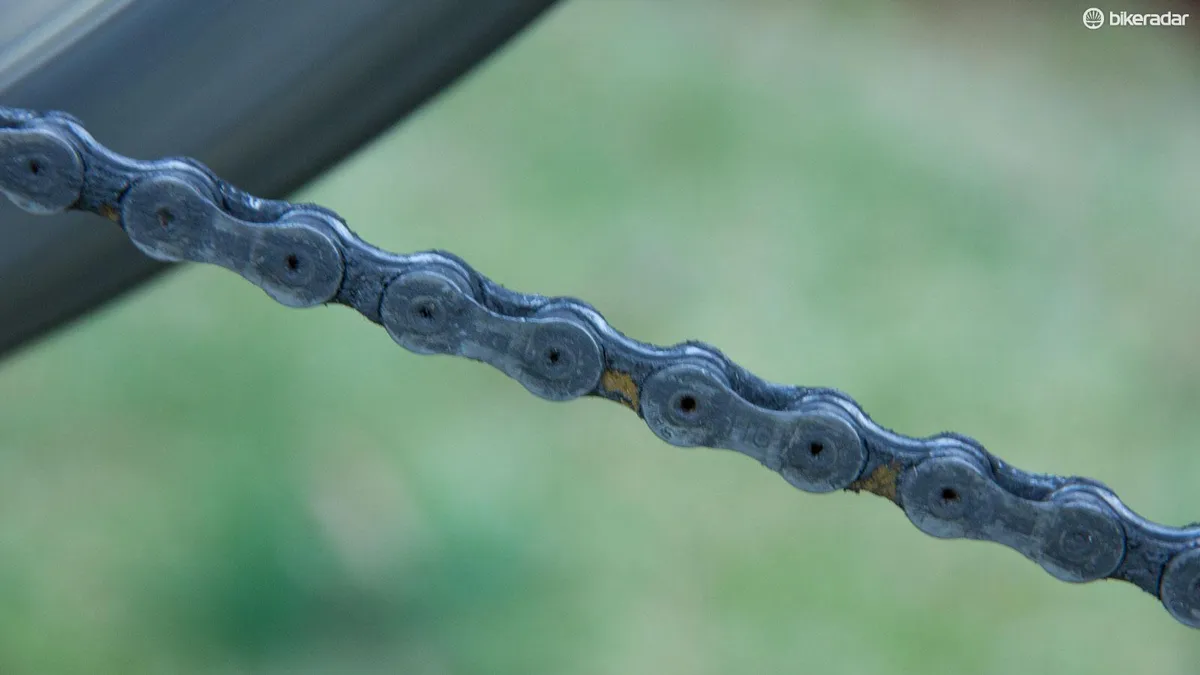
Drivetrain efficiency describes how much of the energy you put through the pedals reaches the rear wheel, to drive you and the bike forward. This energy is usually described as 'power' because it can be measured in watts.
Under laboratory conditions, geared bicycle drivetrains have been shown to reach above 98 per cent efficiency, meaning just 2 per cent of energy inputted is lost to friction.
Real-world conditions don't usually mimic those of a laboratory though.
As well as correct lubrication, drivetrain efficiency is dependent on things such as cleanliness, chain line, and the size of the chainrings and cogs in your drivetrain.
With that in mind, avoiding a contaminated drivetrain is key to optimum efficiency.
Types of chain lube

There are many different types of bicycle-specific lubes, including wet lubes, dry lubes, ceramic lubes and wax lubes. Each has its own pros and cons, and intended use, which we'll come on to.
Most lubes contain synthetic oils, along with friction-reducing additives such as PTFE (Teflon) and carrier fluids that evaporate after application.
Recently, partly thanks to the increased availability of independent testing data, waxed-based lubricants have risen in popularity among performance-minded cyclists.
The key with bicycle chain lubrication is to get it in the internals of the chain (among the rollers and pins). Before lubricating, you also need to clean it as thoroughly as possible, to remove contaminants.
Chain lubes range greatly in price, from a few pounds/dollars at the very low end, to more than £80 at the very top end.

Budget-conscious cyclists ought to consider the full cost of maintaining a drivetrain when making lube purchasing decisions, though.
A cheap lube could end up costing you a lot more overall than an expensive one, for example. If your lube leads to poorer efficiency and increased drivetrain wear, having to replace worn parts of your bike more often will undoubtedly cost a lot more in the long run than an efficient lube.
That said, just because something costs more, it doesn’t mean it’s automatically better.
For a more information on the types of chain lubes available and how they stand up to scrutiny, we spoke to Adam Kerin of Zero Friction Cycling (ZFC), an independent test lab for bicycle chain lubricants.
Dry lube
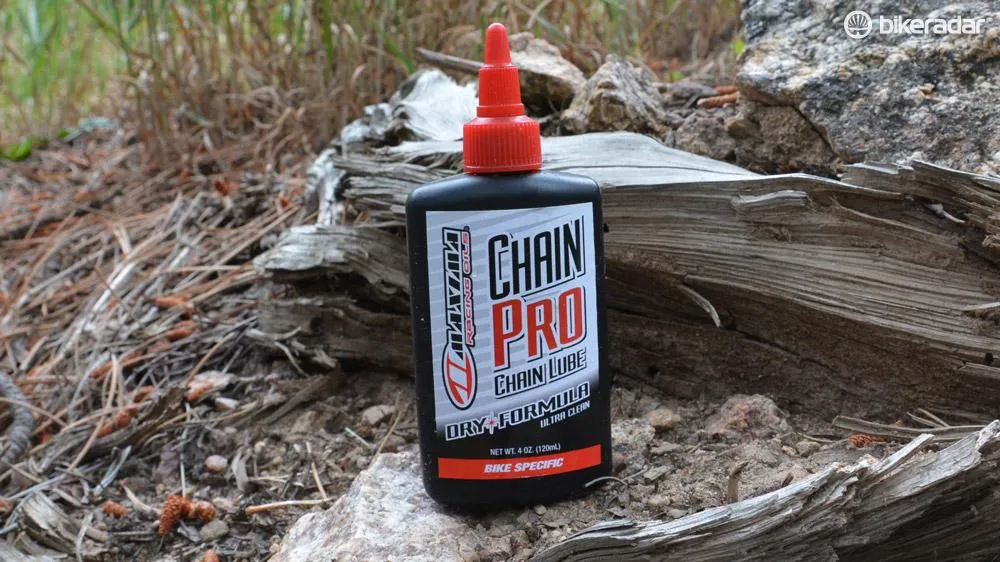
Dry lubes, so-called because they’re designed for riding in dry conditions, are often made up of around 10 per cent lubricant – synthetic oils and additives – and 90 per cent carrier fluid.
Some companies label wax-based lubes as 'dry' too, but we'll cover them separately shortly.
As a lower viscosity lubricant, dry lubes promise greater efficiency through lower friction and by attracting fewer contaminants.
The downside of dry lubes is they are often very easily washed off by rain or puddles.
Zero Friction Cycling (ZFC) suggests dry lubes typically appear cleaner because they lack enough actual lubricant to be effective. This has the knock-on effect of meaning they usually result in high levels of friction and wear, according to ZFC's testing.
If that’s to be believed, you could also make an argument that you’re spending your money mostly on carrier fluid that’s designed to disappear into thin air.
Wet lube
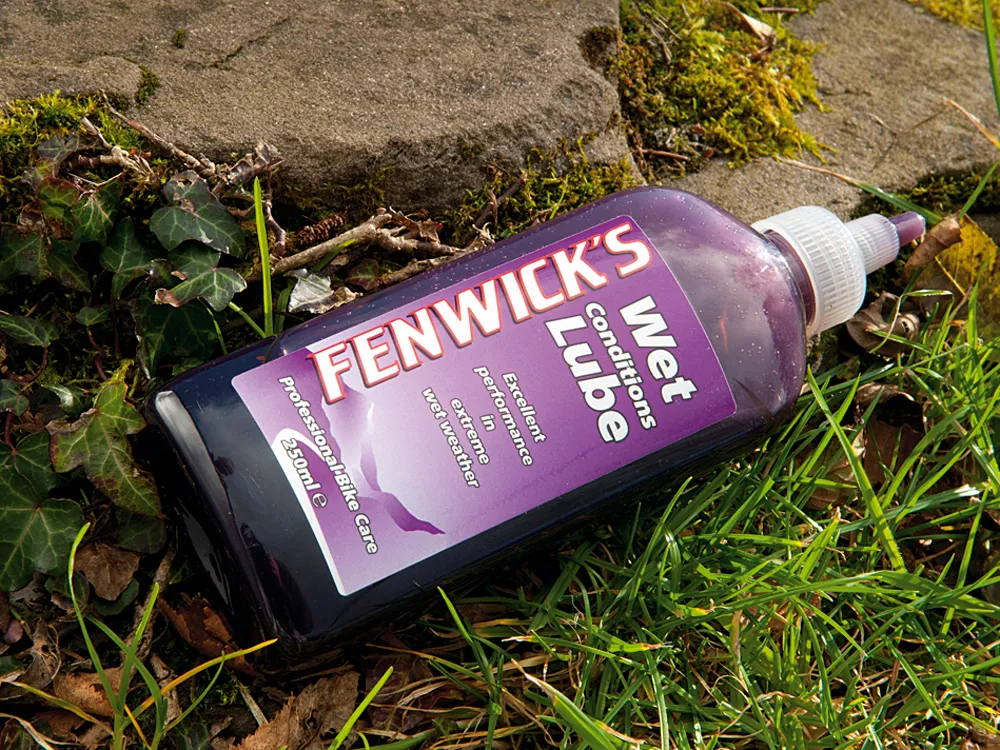
Designed for riding in wet or year-round conditions, wet lubes generally contain greater quantities of higher viscosity synthetic oils, as well as additives such as PTFE.
You get more lubricant per millilitre with this type of lube and the increased viscosity of the oils means this type of lubricant should last longer and is much less prone to getting washed off your chain if you encounter water.
The downside of wet lubes? These same properties also make it a magnet for dirt and grime (especially if applied excessively), and the extra viscosity also means lower outright efficiency compared to thinner lubes, due to the added viscous friction.
Best practice for this type of lube is to apply sparingly to each link in the chain and wipe off any excess before riding.
You’ll need to clean your drivetrain regularly, possibly even after every ride if you want the maximum benefit and to maintain peak performance and optimise drivetrain life. Once a wet lube becomes contaminated it can begin to cause drivetrain wear.
Ceramic lube
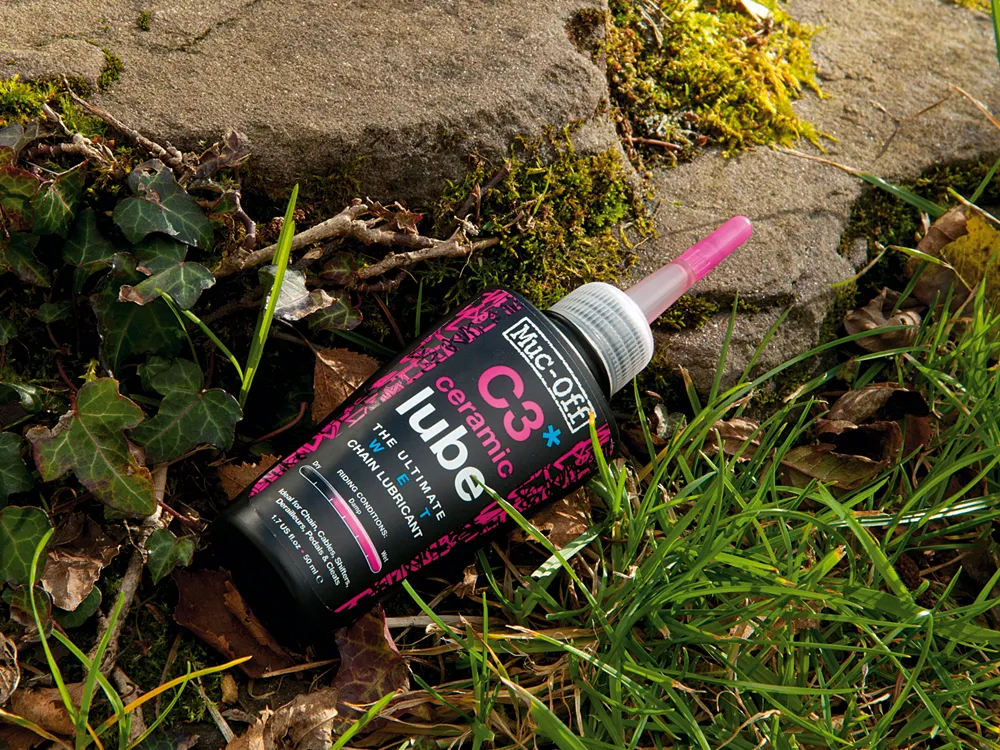
Ceramic lubes have started popping up over the last few years, with bold claims about increased performance, alongside increased prices. It’s not always clear what they contain or what benefits they offer over other types of lubricants, though.
Muc-Off, which makes both wet and dry ceramic lubes, says its ceramic lube contains tiny ‘ceramic particles’ that help reduce friction over the synthetic oils found in standard dry and wet lubes.
It notes these lubes are more expensive, but also points out the decreased friction it claims ought to lead to increased drivetrain longevity, saving you money overall.
ZFC, however, says there is limited publicly available data to substantiate the claims that ceramic lubricants actually provide the purported effects, and thus doesn’t recommend them.
All thing's considered, until they have been definitively proven to work as advertised, it's hard to recommend ceramic lubes over more affordable options.
Wax lube

Lubricants based on paraffin wax (yes, the stuff they make candles with) have grown massively in popularity in recent years, as independent testing has shown them to score extremely well on efficiency, longevity and in resistance to contaminants.
Waxed-based lubricants are usually a mix of highly-refined paraffin wax particles, mixed with additives such as PTFE and a carrier fluid.
The key to wax’s good performance is that, when applied correctly, it settles to form a hard, almost dry layer of low friction lubricant on the chain.
This increased dryness is key because it prevents friction-increasing contaminants from sticking to the chain and working their way into the internals of the chain or coating your drivetrain parts.
A downside of wax lubricants is that they require a fastidiously clean chain prior to the initial application, otherwise the wax won’t stick to the metal or dry out correctly.
This means you’ll have to completely strip even a brand new, box-fresh chain of all grease and oil.
You also need to leave enough time before you ride for the wax to completely dry and harden on the chain (overnight, ideally). If you ride in wet conditions the chain will also need to be cleaned, dried and lubricated soon afterwards to prevent corrosion.
Immersive waxing
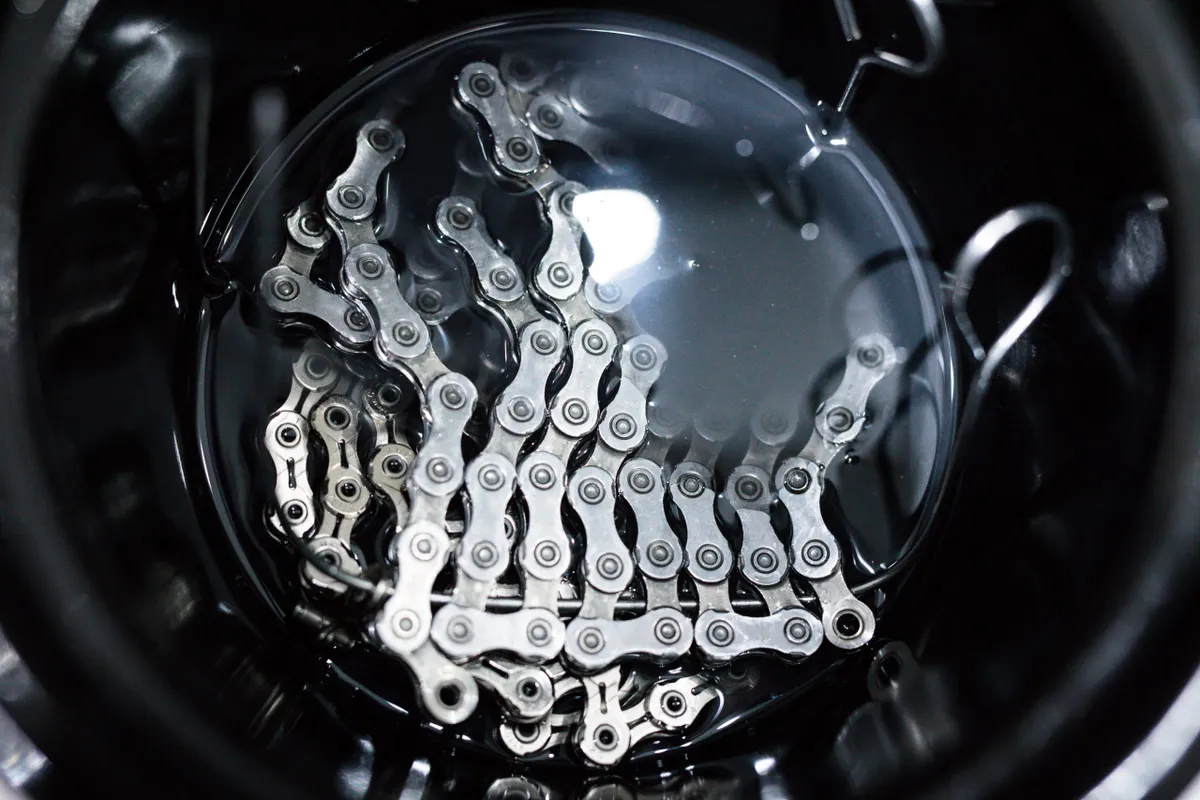
If you’re after the fastest, most efficient drivetrain possible, immersive waxing is currently best. Look around any professional race or time trial and you’re bound to spot more than a few waxed chains.
This process involves taking a scrupulously clean chain and immersing it in a heated vat of highly refined paraffin wax and other additives.
Wax for chain waxing is commercially from brands such as Molten Speed Wax, Silca or Finish Line.
You can source the ingredients separately yourself, but ZFC says that commercial blends such as Molten Speed Wax use more highly refined paraffin wax than what is normally available to consumers, for optimum performance and cleanliness.
The heat helps the chain parts expand, allowing the lubricants to fully penetrate all parts of the chain and flush out contaminants. Once the chain is removed, the wax also dries to a completely dry, solid layer of lubricant over every part.
If you fancy giving it a go yourself, check out our in-depth guide on how to wax a chain.
Is chain waxing difficult?

If you’re thinking, “That sounds like quite a lot of hassle…”, you wouldn’t be wrong – and even some pro teams aren't convinced the purported benefits of waxed chains are worth the extra hassle.
But in our experience, the hard part of immersive waxing is usually the initial chain cleaning process.
The factory grease can be hard to completely remove from the inside of even a brand-new chain. You need strong degreasers or solvents to get the job done properly, and you'll be left with a fair amount of waste chemicals that you’ll need to dispose of carefully.
Once it’s been properly cleaned and treated, waxed chains have, in our experience, an incredible ability to shrug off dirt and grime.
A little extra legwork then, but the potential rewards are substantial.
What about grease?
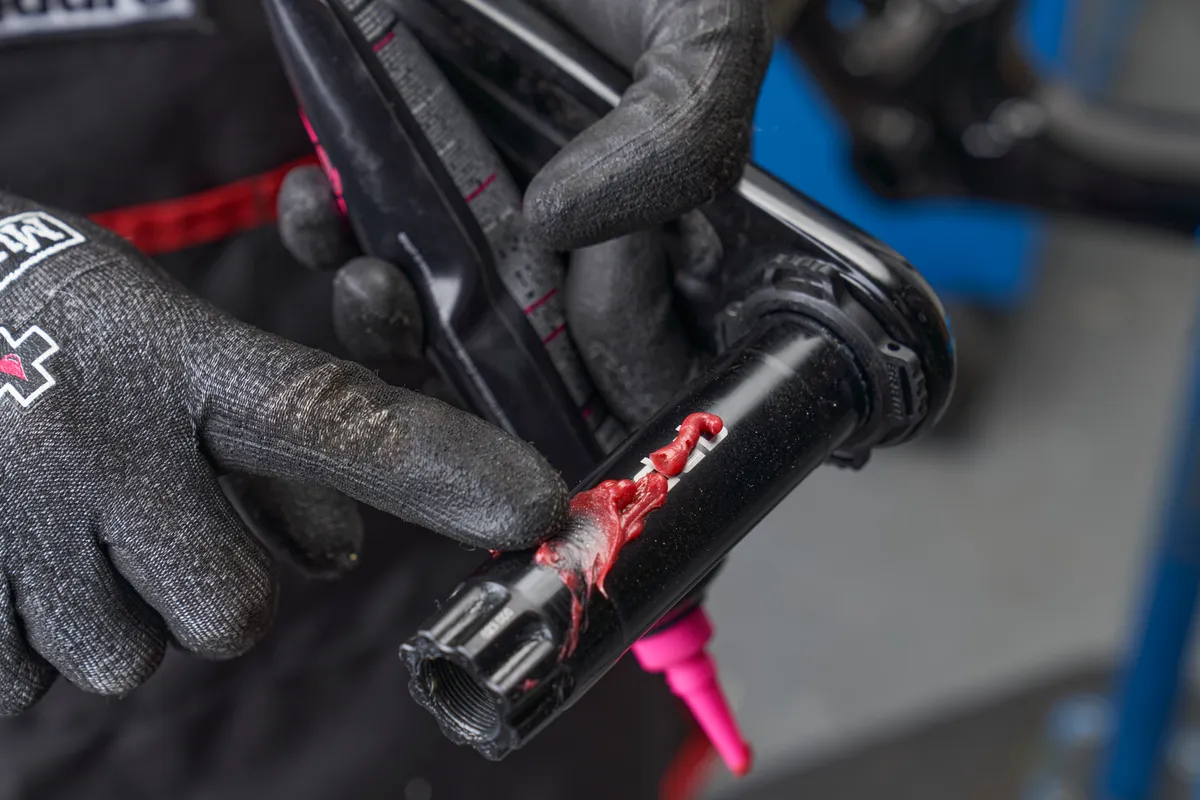
This section is really here to advise against using grease to lubricate your chain.
While grease is great for bearings and threads, it won’t penetrate the gaps between the rollers and pins where you really need the lubricant because it’s far too thick. The viscous friction will be much higher too.
It’s also going to attract every bit of grit, dirt and grime you come across and will be a nightmare to clean off properly afterwards.
Unless your bike ride is planned to take place underwater, we’d recommend steering well clear of using grease on your chain.
Do aerosol lubes work?

Some lubricants are also sold as aerosols, but we wouldn’t recommend these for lubricating chains because they’re very difficult to apply precisely.
The risk of getting lubricant on your wheel's brake track, disc brake rotors or worse in the pads is much higher than with drip lubes, and you really don’t want that happening because it can seriously affect brake performance.

